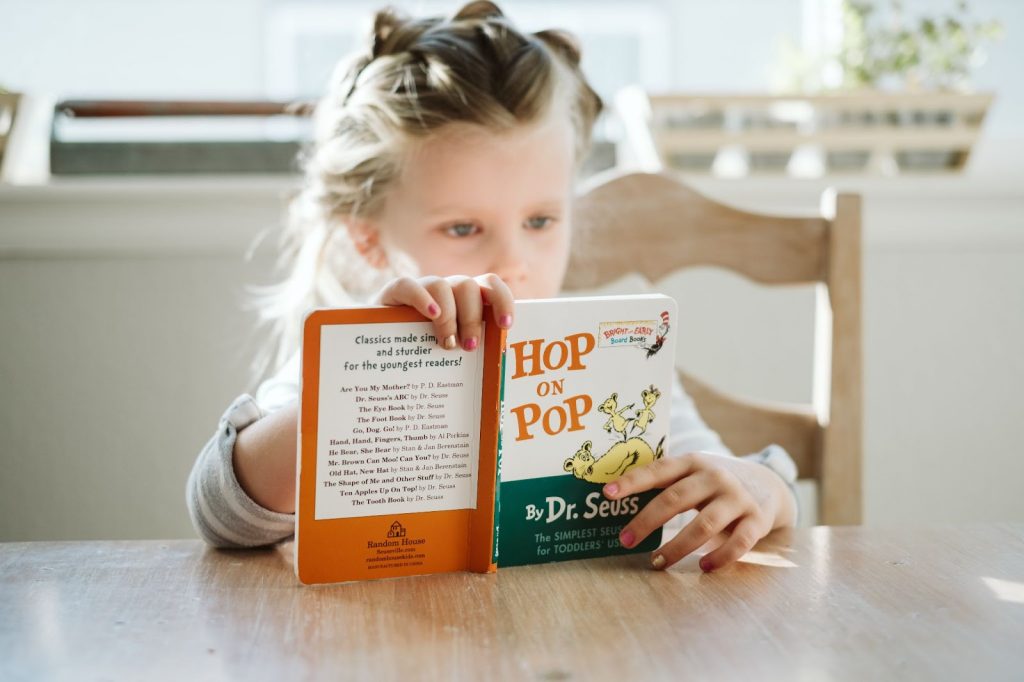It can be quite a task getting young students to develop a reading habit, isn’t it? One thing that will make it super easy is setting reading goals for students. By setting achievable and realistic reading goals, students will be able to take control of their learning and are going to stay motivated to read more.
Math & ELA | PreK To Grade 5
Kids see fun.
You see real learning outcomes.
Watch your kids fall in love with math & reading through our scientifically designed curriculum.
Parents, try for free Teachers, use for free
And the same is true for reading goals. When you set reading goals for students, you give them an opportunity to bring a positive change in their lives, enhance their academic success and foster a lifelong love for reading. So let’s move and explore how you can do that for your studemts!
Related Reading: How to Teach Reading to Kids: 10 Best Strategies for Parents
7 Ways To Set the Right Reading Goals for Students
When we want students to enjoy reading throughout their lives, it’s important to set goals for what they read. These goals should match what each student likes and needs, which makes them understand better and like reading more. These are some of the best ways for teachers and parents to create the right reading goals. This helps students have a great time reading and learning.
“Goals allow you to control the direction of change in your favor” – Brian Tracy
1. Set Smart Goals

If you find yourself asking “What are reading goals”, this is where you should be starting from. SMART goals are deemed effective due to their specific criteria, which include being measurable, achievable/attainable, relevant/realistic, and time-bound. The acronym “SMART” stands for
- Specific
- Measurable
- Achievable/Attainable
- Relevant/Realistic
- Time-bound
To ensure that all criteria are met, goals can be expressed in the following structure: “By (date) and with (materials/support), (action) will be accomplished by my child with a (degree of accuracy).”
When setting a goal for your child, make sure you’re specific with what exactly you want them to learn by the end of the set time frame. The five components you should focus on when setting a reading goal are phonemic awareness, phonics, fluency, vocabulary, and reading comprehension. Let’s break down each of these components and understand what they really mean and how you should be setting measurable goals around them:
Phonemic Awareness
Phonemic awareness refers to the capacity to recognize and manipulate individual sounds (phonemes) within spoken words. Proficiency in phonological awareness serves as a reliable indicator of a student’s future reading achievement or challenges. Phonemic awareness activities exclusively focus on the tiniest sound units. For instance, having the ability to perceive the sounds /c/, /a/, and /t/ in the word “cat” necessitates phonemic awareness. Another one of the best examples of reading goals for students in this component is recognizing the sounds /sh/, /a/, and /ck/ in the word “shack.” These sounds cannot be further subdivided.
Phonics
Phonics entails associating the sounds of spoken English with specific letters or letter combinations. For instance, the sound “k” can be represented by various spellings such as “c,” “k,” “ck,” or “ch.” By instructing children to blend these letter sounds together, they acquire the ability to decode unfamiliar words by sounding them out.
Related Reading: How to Teach Phonics to Kids - Step By Step Guide
Reading Fluency
Fluent reading encompasses the capacity to read at an appropriate speed, with accuracy, and with expressive delivery. In order to comprehend the content they read, kids need to possess fluency in reading. This proficiency is vital for both silent reading as well as reading aloud.
Vocabulary
Your vocabulary encompasses the complete set of words you are familiar with in a specific language. It is of utmost importance for children to receive clear and comprehensive instruction in vocabulary to enhance their oral and written communication skills. Explicit vocabulary teaching enables students to grasp academic language and engage in meaningful discussions, thereby enhancing their understanding of complicated texts.
Reading Comprehension
Reading comprehension refers to the skill of effectively reading a text, processing its content, and comprehending its intended meaning. This proficiency relies on two interconnected abilities: word reading, which involves decoding the symbols on the page, and language comprehension, which involves understanding the meaning of words and sentences. Without comprehension, children cannot derive meaning from their reading. Comprehension strategies are employed to enhance children’s understanding of the text, enabling them to become active readers who engage with the content.
Related Reading: Best Educational Goal Examples that Matter for Students & Teachers
2. Discover Their Reading Identity

As a teacher, you’d know that every kid is special in their own way. They have their own interests, likes and dislikes. The same is valid for reading identities as well. To discover their reading identity, engage in meaningful conversations with your kids, and create a safe and inclusive environment where they can openly share their thoughts and experiences about reading. Discuss their favorite genres, authors, and books that have influenced them. Simultaneously, incorporate the question, “Who are you as a reader now?” into these discussions.
In addition to conversations, use surveys, reflections, or one-on-one and small group discussions to facilitate a deeper understanding of your kids’ reading identities. These methods allow students to express their perspectives on their reading abilities, interests, and challenges they may face. By actively listening to their responses, you gain important insights into their current reading status and can tailor your support accordingly.
The best way to creating a comprehensive approach and helping students set meaningful reading goals is integrating the question of self identity in the initial steps of the process. Understanding how they perceive themselves as readers empower you to guide them in selecting appropriate goals that address their unique needs and aspirations.
3. Goal Setting Discussions

One of the key steps in helping set reading goals for students is to engage them in collaborative discussions about goal setting. In a survey conducted by Scholastic, it was found that 92% of students who set reading goals felt more confident about their reading abilities. By involving students in this process, you empower them to take ownership of their reading journey and develop a sense of accountability toward their goals. Here is a step by step guide to goal setting for students.
Step 1: Create a Supportive Environment
Begin by creating a supportive and inclusive atmosphere where kids feel comfortable sharing their thoughts and ideas. Encourage open dialogue by asking questions such as, “What are your aspirations as a reader?” or “What specific reading skills would you like to improve?”. By initiating these conversations, you foster a sense of reflection and self-awareness among students.
Step 2: Encourage Them to Set SMART Goals
During these discussions, encourage students to set Specific, Measurable, Attainable, Relevant, and Time-bound (SMART) goals and create a list of reading goals for students. Guide them to think about their current reading abilities and identify areas where they can challenge themselves to grow. Emphasize the importance of setting goals that are realistic and aligned with their interests and aspirations.
Step 3: Make Them Break Their Goals into Smaller Milestones
Help kids understand that progress is made through small, achievable steps. Encourage them to identify short-term objectives that will ultimately contribute to their long-term reading goals.
Step 4: Explore Strategies to Help Them Achieve Their Goals
Explore strategies and resources that can support in achieving reading goals for students. Collaboratively brainstorm ideas for incorporating reading into their daily routines, exploring different genres, or seeking out diverse reading materials. By involving students in this brainstorming process, you tap into their creativity and make goal setting an exciting and personalized experience.
Step 5: Revisit & Review Their Goals Regularly
Schedule follow-up discussions to check their progress, provide feedback, and celebrate milestones. This ongoing dialogue reinforces the importance of goal setting and helps students stay focused and motivated. By engaging students in discussions about goal setting, we empower them to take ownership of their basic reading goals and foster a sense of agency in their learning. This collaborative approach not only increases their motivation but also ensures that their goals are meaningful, relevant, and tailored to their individual needs.
4. Personalize Their Goals

Once you have discussed goal setting with your students, it’s important to partner with them to personalize their goals. This means helping them choose goals that are relevant and meaningful to them. Here is how you can do it.
- One way to do this is to ask questions such as, “What are some books or topics that you’re interested in reading?” or “What are some skills you want to improve as a reader?” This will help you guide them towards goals that align with their interests and needs.
- When personalizing a goal, make sure that the goals are challenging yet achievable for each student. You can use data from assessments, observations, and conversations to help determine a realistic yet challenging goal for each student.
5. Complete the Goal Form
Completing the goal form is an essential step in helping set and track the reading goals for students. This form serves as a tangible representation of their aspirations and acts as a roadmap for their reading journey. Start by providing a structured goal form that includes sections to write the specific reading goals for students, the steps they plan to take to achieve them, and a timeline for completion.
Encourage students to be specific and measurable when writing their goals. For example, instead of stating, “I want to read more,” a specific goal could be, “I will read at least three books from different genres each month.” By setting clear parameters, students can monitor their progress and celebrate their achievements along the way. Additionally, guide students in identifying the steps they need to take to reach their goals. These steps could include allocating dedicated reading time, exploring various genres, seeking recommendations, or using specific reading strategies. Encourage students to break down their goals into smaller, manageable tasks to make progress more tangible.
Once the goal forms are completed, have regular check-ins with students to review their progress. Celebrate their accomplishments, provide feedback, and offer support where needed. This ongoing reflection and accountability will help students stay focused and motivated towards achieving their reading goals. Completing a goal form provides students with a visual reminder of their goals, helps them take ownership of their progress, and fosters a sense of responsibility. It serves as a powerful tool for students to track their reading journey and reflect on their growth as readers.
6. Create Space for Daily Reminders

Creating space for daily reminders is crucial in helping stay committed to their reading goals for students. By establishing a visual and tangible reminder, students are encouraged to prioritize their reading habits and make progress toward their goals. Let’s explore how you can help create daily reminders for them.
1. Designate a Specific Area
Start by designating a specific area in the classroom or at home as a reading reminder space. This can be a bulletin board, a corner with motivational quotes and book recommendations, or even a digital platform where students can access reading resources. Ensure that the space is visually appealing and inviting, capturing the excitement and importance of reading.
2. Incorporate Tools
Within this reminder space, incorporate tools that prompt students to engage with their reading goals on a daily basis. This can include goal trackers, reading logs, or personalized bookmarks.
3. Encourage Them to Document Their Progress
Encourage students to update these tools regularly, documenting their reading progress and reflecting on their achievements. This active involvement fosters a sense of ownership and motivation.
4. Encourage Engagement
Furthermore, incorporate regular discussions and reflections on reading goals for kids during class time. Dedicate moments to review progress, celebrate milestones, and provide ongoing support. Encourage students to share their experiences, recommend books to one another, and offer encouragement. By creating a community where reading goals are valued and celebrated, students feel supported and motivated to continue their reading journey.
7. Support Your Students

A study published in the Journal of Child Psychology and Psychiatry showed that early reading habits in children are associated with enhanced language skills, higher intelligence, and improved socio-emotional development. If you provide the right support, your students can greatly benefit from reading. Developing a comprehensive plan to support your students is a crucial step in helping them achieve their reading goals. Read on to explore how you can support them in this journey.
1. Identify Where They Need Extra Support
Start by assessing the individual needs of your students and identifying areas where they may require additional support. This can be done through formative assessments, observations, and ongoing conversations.
2. Change Your Startegies Accordingly
Once you have a clear understanding of their needs, tailor your instruction and resources accordingly. Differentiate your teaching strategies to accommodate varying reading levels and learning styles within your classroom. Provide a range of books and materials that cater to different interests and abilities, ensuring that each student has access to appropriate reading materials. Implement regular progress monitoring to track your students’ growth and adjust your support as needed. This can include periodic assessments, reading conferences, and check-ins to evaluate their progress towards their goals. Use this data to provide targeted feedback and offer specific strategies to help them overcome challenges.
3. Create a Supportive Community
Furthermore, foster a culture of reading by integrating literacy activities and discussions into your daily routines. Encourage students to share their reading experiences, recommend books to one another, and celebrate reading achievements as a community. You can do this with literary circles, partner work, group discussions, and guided reading.
Related Reading: Best Reading Websites For Kids
Conclusion
“Today a reader, tomorrow a leader.” This quote by Margaret Fuller perfectly sums up how important reading is for kids. From setting SMART goals to personalizing them, completing goal forms, and planning for ongoing support, you can empower kids or students to become active and motivated readers. By nurturing their reading identity and providing daily reminders, you can cultivate a lifelong habit of reading that will help them throughout their lives. Let’s try our best to foster a healthy reading habit and make their futures bright!
Frequently Asked Questions (FAQs)
What is the best daily reading goal?
Generally, 15 pages a day is a healthy reading goal for adults. For kids, this may vary from one person to another, depending on their age and reading personality.
Does goal setting have any impact on the reading habit development of kids?
Yes, according to the National Reading Panel Report published in 2000, setting explicit reading goals and providing explicit instruction can really help kids develop healthy reading habits.
Why is reading a good habit for kids?
Reading habit is great for kids as it helps them develop various skills, improve their reading and language skills, and enhances their brain functioning.
























